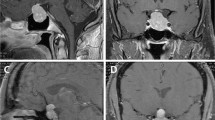Abstract
Purpose
To analyse the antigen expression profiles of 27 cases of pituicytoma, spindle cell oncocytoma, and granular cell tumour of the sellar region concerning a common pituicytic origin of neoplastic cells.
Methods
Material from 12 female and 15 male patients (13 granular cell tumours of the sellar region, 10 pituicytomas, four spindle cell oncocytomas) collected in the German Registry of Pituitary Tumours between 1993 and 2015 was re-evaluated according to the current WHO classification of tumours of the central nervous system and supplementary immunohistochemistry including S100-protein, CD56, CD68, thyroid transcription factor-1 (TTF-1), and Ki-67 was performed.
Results
S100-protein was detected in all 27 tumours and TTF-1 in all 16 tumours that were assessed. Vimentin was expressed in all 13 cases investigated whereas broad spectrum cytokeratin was not detected in any of 14 evaluated cases. GFAP was observed in nine out of 21 cases. 15 out of 17 investigated lesions showed some CD68 expression and five out of 14 cases were labelled with CD56 antibodies. Proliferative activity did not differ significantly between the three tumour subgroups although one primary and one recurrent pituicytoma showed exceptionally high Ki-67-proliferation indices of 15.3 and 12.7 %, respectively (means: granular cell tumour of the sellar region 2.0 %, pituicytoma 2.8 %, spindle cell oncocytoma 2.7 %).
Conclusions
The study confirms and expands earlier data and is in line with the notion that the three tumour types are variants of pituicytoma.

Similar content being viewed by others
References
Ganong WF (2000) Circumventricular organs: definition and role in the regulation of endocrine and autonomic function. Clin Exp Pharmacol Physiol 27:422–427
Mete O, Lopes MB, Asa SL (2013) Spindle cell oncocytomas and granular cell tumors of the pituitary are variants of pituicytoma. Am J Surg Pathol 37:1694–1699
Takei Y, Seyama S, Pearl GS, Tindall GT (1980) Ultrastructural study of the human neurohypophysis. II. Cellular elements of neural parenchyma, the pituicytes. Cell Tissue Res 205:273–287
Lee EB, Tihan T, Scheithauer BW, Zhang PJ, Gonatas NK (2009) Thyroid transcription factor 1 expression in sellar tumors: a histogenetic marker? J Neuropathol Exp Neurol 68:482–488
Louis DN, Ohgaki H, Wiestler OD, Cavenee WK, Ellison DW, Figarella-Branger D, Perry A, Reifenberger G, von Deimling A (eds) (2016) WHO classification of tumours of the central nervous system. IARC, Lyon
Kloub O, Perry A, Tu PH, Lipper M, Lopes MB (2005) Spindle cell oncocytoma of the adenohypophysis: report of two recurrent cases. Am J Surg Pathol 29:247–253
Kasashima S, Oda Y, Nozaki J, Shirasaki M, Nakanishi I (2000) A case of atypical granular cell tumor of the neurohypophysis. Pathol Int 50:568–573
Sternberg C (1921) Ein Choristom der Neurohypophyse bei ausgebreiteten Oedemen. Zentralbl. f. allg. Path. u. path. Anat. 31:585–591
Cone L, Srinivasan M, Romanul FC (1990) Granular cell tumor (choristoma) of the neurohypophysis: two cases and a review of the literature. AJNR Am J Neuroradiol 11:403–406
Saeger W (1981) Hypophyse. In: Doerr W, Seifert G (eds) Pathologie der endokrinen Organe, Teil 2. Springer, Berlin, pp 1–226
Gurzu S, Ciortea D, Tamasi A, Golea M, Bodi A, Sahlean DI, Kovecsi A, Jung I (2015) The immunohistochemical profile of granular cell (Abrikossoff) tumor suggests an endomesenchymal origin. Arch Dermatol Res 307:151–157
Roncaroli F, Scheithauer BW, Cenacchi G, Horvath E, Kovacs K, Lloyd RV, Abell-Aleff P, Santi M, Yates AJ (2002) ‘Spindle cell oncocytoma’ of the adenohypophysis: a tumor of folliculostellate cells? Am J Surg Pathol 26:1048–1055
Hewer E, Beck J, Kellner-Weldon F, Vajtai I (2015) Suprasellar chordoid neoplasm with expression of thyroid transcription factor 1: evidence that chordoid glioma of the third ventricle and pituicytoma may form part of a spectrum of lineage-related tumors of the basal forebrain. Hum Pathol 46:1045–1049
Scheithauer BW, Swearingen B, Whyte ET, Auluck PK, Stemmer-Rachamimov AO (2009) Ependymoma of the sella turcica: a variant of pituicytoma. Hum Pathol 40:435–440
Yoshimoto T, Takahashi-Fujigasaki J, Inoshita N, Fukuhara N, Nishioka H, Yamada S (2015) TTF-1-positive oncocytic sellar tumor with follicle formation/ependymal differentiation: non-adenomatous tumor capable of two different interpretations as a pituicytoma or a spindle cell oncocytoma. Brain Tumor Pathol 32:221–227
Ellis JA, Tsankova NM, D’Amico R, Ausiello JC, Canoll P, Rosenblum MK, Bruce JN (2012) Epithelioid pituicytoma. World Neurosurg 78:191.E1-7
Saeed Kamil Z, Sinson G, Gucer H, Asa SL, Mete O (2014) TTF-1 expressing sellar neoplasm with ependymal rosettes and oncocytic change: mixed ependymal and oncocytic variant pituicytoma. Endocr Pathol 25:436–438
Bielle F, Villa C, Giry M, Bergemer-Fouquet AM, Polivka M, Vasiljevic A, Aubriot-Lorton MH, Bernier M, Lechapt-Zalcman E, Viennet G, Sazdovitch V, Duyckaerts C, Sanson M, Figarella-Branger D, Mokhtari K (2015) on behalf of RENOP: chordoid gliomas of the third ventricle share TTF-1 expression with organum vasculosum of the lamina terminalis. Am J Surg Pathol 39:948–956
Acknowledgments
The tumours included in the present study were drawn from the German Registry of Pituitary Tumours which is sponsored by Novartis Pharma GmbH (Nürnberg), Novo Nordisk Pharma GmbH (Mainz), Pfizer Pharma GmbH (Berlin) and Ipsen Pharma GmbH (Berlin).
Author information
Authors and Affiliations
Corresponding author
Ethics declarations
Conflict of interest
All authors (C. Hagel, R. Buslei, M. Buchfelder, R. Fahlbusch, M. Bergmann, A. Giese, J. Flitsch, D.K. Lüdecke, M. Glatzel, W. Saeger) declare that they have no conflict of interest.
Ethical approval
All procedures performed in studies involving human participants were in accordance with the ethical standards of the institutional and/or national research committee and with the 1964 Helsinki declaration and its later amendments or comparable ethical standards (a separate ethic review and permission of a local committee was not necessary according to §12 of the Hamburgisches Krankenhausgesetz, Hamburg, Germany).
Additional information
On behalf of the pituitary work group of the Deutsche Gesellschaft für Endokrinologie.
Rights and permissions
About this article
Cite this article
Hagel, C., Buslei, R., Buchfelder, M. et al. Immunoprofiling of glial tumours of the neurohypophysis suggests a common pituicytic origin of neoplastic cells. Pituitary 20, 211–217 (2017). https://doi.org/10.1007/s11102-016-0762-x
Published:
Issue Date:
DOI: https://doi.org/10.1007/s11102-016-0762-x




